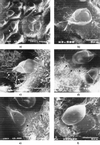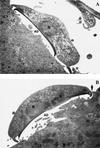Adherence of Giardia lamblia trophozoites to Int-407 human intestinal cells
- PMID: 11238205
- PMCID: PMC96046
- DOI: 10.1128/CDLI.8.2.258-265.2001
Adherence of Giardia lamblia trophozoites to Int-407 human intestinal cells
Erratum in
- Clin Diagn Lab Immunol 2001 May;8(3):669
Abstract
Attachment of Giardia lamblia trophozoites to enterocytes is essential for colonization of the small intestine and is considered a prerequisite for parasite-induced enterocyte dysfunction and clinical disease. In this work, coincubation of Giardia with Int-407 cells, was used as an in vitro model to study the role of cytoskeleton and surface lectins involved in the attachment of the parasite. This interaction was also studied by scanning and transmission electron microscopy. Adherence was dependent on temperature and was maximal at 37 degrees C. It was reduced by 2.5 mM colchicine (57%), mebendazole (10 microg/ml) (59%), 100 mM glucose (26%), 100 mM mannose (22%), 40 mM mannose-6-phosphate (18%), and concanavalin A (100 microg/ml) (21%). No significant modification was observed when Giardia was pretreated with cytochalasins B and D and with EDTA. Giardia attachment was also diminished by preincubating Int-407 cells with cytochalasin B and D (5 microg/ml) (16%) and by glutaraldehyde fixation of intestinal cells and of G. lamblia trophozoites (72 and 100%, respectively). Ultrastructural studies showed that Giardia attaches to the Int-407 monolayer predominantly by its ventral surface. Int-407 cells contact trophozoites with elongated microvilli, and both trophozoite imprints and interactions of Giardia flagella with intestinal cells were also observed. Transmission electron microscopy showed that Giardia lateral crest and ventrolateral flange were important structures in the adherence process. Our results suggest a combination of mechanical and hydrodynamic forces in trophozoite attachment; surface lectins also seem to mediate binding and may be involved in specific recognition of host cells.
Figures




Similar articles
-
Attachment of Giardia lamblia trophozoites to a cultured human intestinal cell line.Gut. 1995 Oct;37(4):512-8. doi: 10.1136/gut.37.4.512. Gut. 1995. PMID: 7489938 Free PMC article.
-
Role of cytoskeleton and surface lectins in Giardia duodenalis attachment to Caco2 cells.Parasitol Res. 1991;77(8):659-62. doi: 10.1007/BF00928679. Parasitol Res. 1991. PMID: 1805208
-
Inhibition of in vitro attachment of Giardia trophozoites by mucin.J Parasitol. 2002 Oct;88(5):869-73. doi: 10.1645/0022-3395(2002)088[0869:IOIVAO]2.0.CO;2. J Parasitol. 2002. PMID: 12435122
-
Recent insights into the mucosal reactions associated with Giardia lamblia infections.Int J Parasitol. 2005 Nov;35(13):1339-47. doi: 10.1016/j.ijpara.2005.07.008. Epub 2005 Aug 24. Int J Parasitol. 2005. PMID: 16182298 Review.
-
Imaging and analysis of the microtubule cytoskeleton in giardia.Methods Cell Biol. 2010;97:307-39. doi: 10.1016/S0091-679X(10)97017-9. Methods Cell Biol. 2010. PMID: 20719278 Review.
Cited by
-
The FAD-dependent glycerol-3-phosphate dehydrogenase of Giardia duodenalis: an unconventional enzyme that interacts with the g14-3-3 and it is a target of the antitumoral compound NBDHEX.Front Microbiol. 2015 Jun 1;6:544. doi: 10.3389/fmicb.2015.00544. eCollection 2015. Front Microbiol. 2015. PMID: 26082764 Free PMC article.
-
High-speed microscopic imaging of flagella motility and swimming in Giardia lamblia trophozoites.Proc Natl Acad Sci U S A. 2011 Aug 23;108(34):E550-8. doi: 10.1073/pnas.1106904108. Epub 2011 Aug 1. Proc Natl Acad Sci U S A. 2011. PMID: 21808023 Free PMC article.
-
Disadvantaged pre-schoolers attending day care in Salvador, Northeast Brazil have a low prevalence of anaemia and micronutrient deficiencies.Public Health Nutr. 2014 Sep;17(9):1984-92. doi: 10.1017/S1368980013002310. Epub 2013 Sep 5. Public Health Nutr. 2014. PMID: 24008015 Free PMC article.
-
Novel structural components of the ventral disc and lateral crest in Giardia intestinalis.PLoS Negl Trop Dis. 2011 Dec;5(12):e1442. doi: 10.1371/journal.pntd.0001442. Epub 2011 Dec 20. PLoS Negl Trop Dis. 2011. PMID: 22206034 Free PMC article.
-
Rab11 and actin cytoskeleton participate in Giardia lamblia encystation, guiding the specific vesicles to the cyst wall.PLoS Negl Trop Dis. 2010 Jun 1;4(6):e697. doi: 10.1371/journal.pntd.0000697. PLoS Negl Trop Dis. 2010. PMID: 20532229 Free PMC article.
References
-
- Bourinbaiar A R, Nagorny R. Inhibitory effect of natural interferon alpha on immunodeficiency virus type 1 transmission from epithelial cells to lymphocytes in vitro. Eur J Pharmacol. 1993;230:15–22. - PubMed
-
- Chaves B, Martinez-Palomo A. Giardia lamblia: freeze-fracture ultrastructure of the ventral disc plasma membrane. J Eukaryot Microbiol. 1995;42:136–141. - PubMed
-
- Chavez B F, Knaippe L, Gonzalez-Mariscal, Martinez-Palomo A. Giardia lamblia: electrophysiology and ultrastructure of cytopathology in culture epithelial cells. Exp Parasitol. 1986;61:379–389. - PubMed
-
- Crouch A A, Seow W K, Whitman L M, Smith S E, Thong Y H. Inhibition of adherence of Giardia intestinalis by human neutrophils and monocytes. Trans R Soc Trop Med Hyg. 1991;85:375–379. - PubMed
-
- Dykstra M J. A manual of applied techniques for biological electron microscopy. New York, N.Y: Plenum Press; 1993. pp. 60–64.
MeSH terms
Substances
LinkOut - more resources
Full Text Sources
Other Literature Sources

